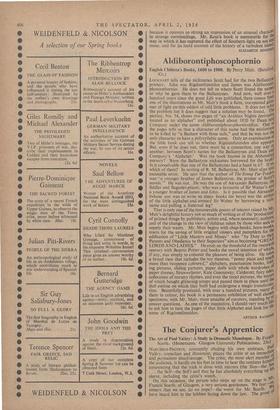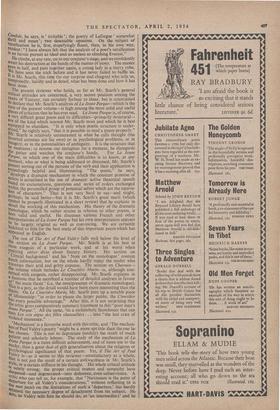The Conjurer's Apprentice
sleeve, including the critic's watch. Vt.
Candide, he says, is ' irritable '; the poetry of Laforgue somewhat Shrill and mean' ; two detestable opinions. On the subject of Versification he is, first, stupefyingly fluent, then, in his own way, Modest: "I have always felt that the analysis of a poet's versification is an heroic pursuit as ideal and as useless as climbing Everest." He climbs, at any rate, on to our conjurer's stage, and we confidently await his destruction at the hands of the master of irony. The master saws in half, and puts together again, a young lady in a starry robe. We have seen the trick before and it has never failed to baffle us. It is Mr. Scarfe, this time (to our surprise and chagrin) who tells us, e,eMposedly, lucidly and in detail, what has been done and how it has been done.
The present reviewer who holds, as far as Mr. Scarfe's general critical attitudes are concerned, a very secure position among the ranks of Tuscany, can certainly forbear to cheer, but is constrained to declare that Mr. Scarfe's analysis of La Jeune Parque—which is the core of the present volume—is high among the most solid and useful eces of criticism that he has ever read. La Jeune Parque is, of course, very difficult great poem and its difficulties—primarily structural— e of the kind which interest Mr. Scarfe most and which he is best quipped to elucidate. "It is only when poetic structure is under- tood," he rightly says, "that it is possible to read a poem properly." r. Scarfe is relatively uninterested in what he calls thought (the averted commas are his own) or in psychological problems, or in gery, or in the potentialities of ambiguity. It is the structure that e measures; to resume our metaphor for a moment, he disregards the patter and watches the conjurer's hands. For La Jeune Parque, in which one of the main difficulties is to know, at any moment, who or what is being addressed or discussed, Mr. Scarfe's Patient sorting out of the persons of the verb and their application is exceedingly helpful and illuminating. "The poem," he says, develops a dramatic mechanism in which the constant promise of action is actualised in the use of dramatic active theatrical speech based on exclamations, questions and series of orders exchanged Within the personified group of potential selves which are the equiva- lent of characters." That is not very hard to say—and might, Perhaps, be said better—but it is Mr. Scarfe's great merit (which ..,_eannet be properly illustrated in a short review) that he explains in etail the working of this mechanism. His theory of the dramatic !nonologue, which he rather strains in relation to other poems, is Pere valid and useful. He discusses various French and other 1-interpretations of La Jeune Parque but his own interpretation appears be largely original as well as convincing. We are certainly Indebted to him for the best study of this important poem which has appeared in English.
the rest of The Art of Paul Valery falls well below the level of we, section on La Jeune Parque. Mr. Scarfe is at his best in close exegesis of a particular work, and at his worst when emitting obiter dicta about literary history. His section on Critical background ' and his Note on the monologue ' contain much information, but on the whole hardly repay the reader who _traverses their arid and gritty expanse. The section on Charmer— tile volume which includes Le Cimetiere Main—is, although con- cerned with exegesis, rather disappointing. Mr. Scarfe explains in Potnote that he sacrificed a number of detailed analyses in favour c1f the main thesis' (i.e. the omnipresence of dramatic monologue). &Ins is a pity, as the detail would have been more interesting than the thesis On Le Cimetiere Marin, Mr. Scarfe puts up a notable piece tifemanship: "in order to please the larger public, the Cimetiere the every possible advantage." After this, it is not surprising that "le critic gives comparatively summary treatment to this "poor man's Jeune Parque." All the same, 'tis a melancholy Scotchman that can turn Les cris aigus des filles chatouillies . into "the last cries of violated innocence."
1,, 'Mechanism' is a favourite word with this critictiled n 'The mechan- el of Paul Valery's poetry' might be a more apt than the one he 44s chosen. This is not to depreciate (unduly) the result of much Patient and scholarly labour. The study of the mechanism of La r4 une Parque is a more difficult achievement, and of more use to the ender, than a great deal of glib generalisation about the religious or f'sYchological significance of that poeM. Yet, if The Art of Paul „alert' is--as it seems to this reviewer—unsatisfactory as a whole, that is not just the result of a certain awkwardness in Mr. Scarfe's is subtly or a certain stiffness in his thought. His whole critical attitude concentrates, as Valery would wish him to do, on the 'mechanism, If he follows the movement of the conjurer's hands, it is because the conjurer himself has told him to do so: he is a useful part of the act. But he fooled us for a moment by pretending to be a member of the audience.
DONAT O'DONNEI1




















































 Previous page
Previous page